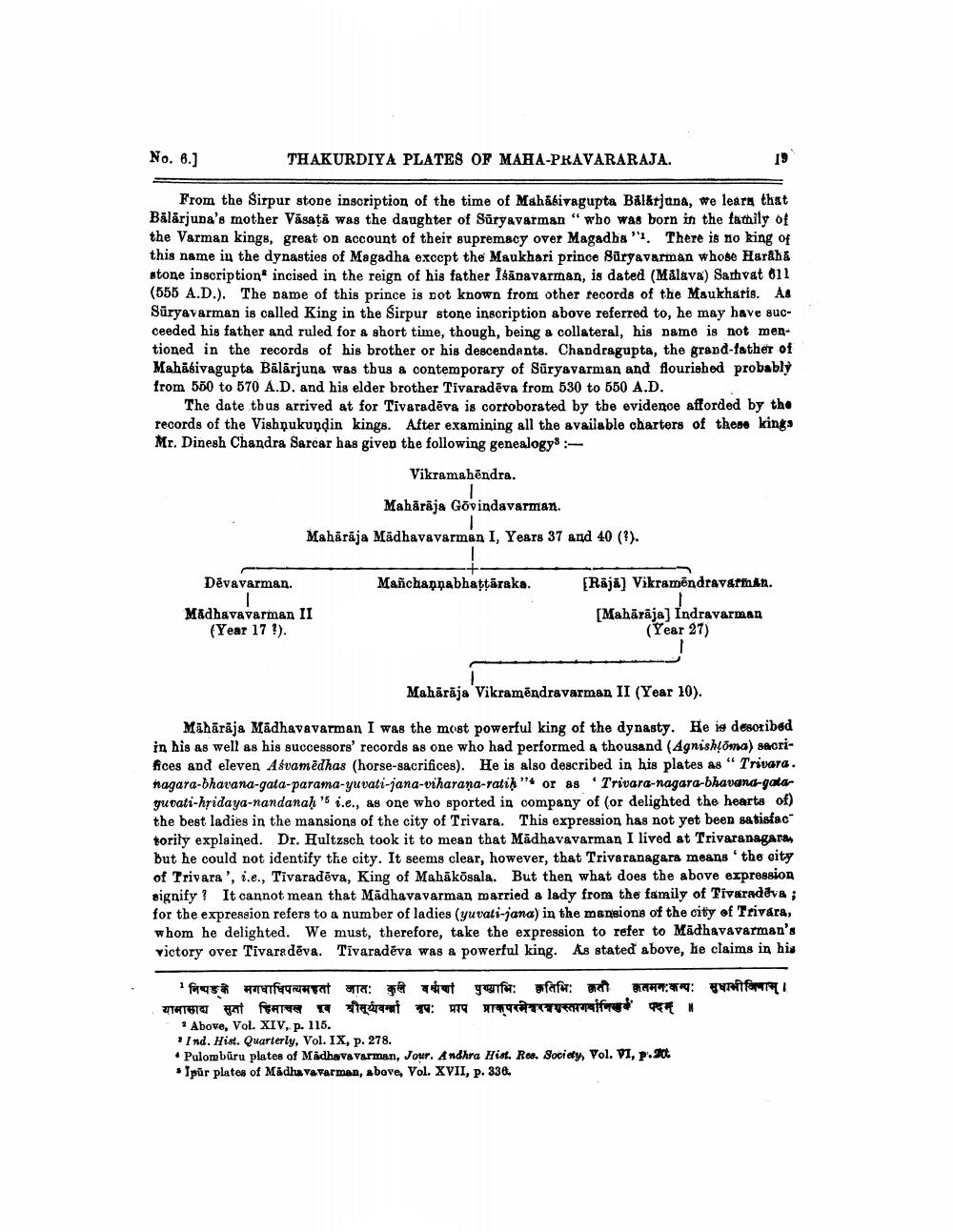________________
No. 6.]
THAKURDIYA PLATES OF MAHA-PRAVARARAJA.
From the Sirpur stone insoription of the time of Mahabivagupta Bal&rjana, we learn that Bālārjuna's mother Väsaţă was the daughter of Suryavarman "who was born in the fathily of the Varman kings, great on account of their supremacy over Magadha "1. There is no king of this name in the dynasties of Magadha except the Maukhari prince Suryavarman whose Hardha stone inscription incised in the reign of his father isānavarman, is dated (Málava) Samvat 011 (555 A.D.). The name of this prince is not known from other records of the Maukhatis. As Suryavarman is called King in the Sirpur stone inscription above referred to, he may have succeeded his father and ruled for a short time, though, being a collateral, his name is not mentioned in the records of his brother or his descendants. Chandragupta, the grand father of Mahāśivagupta Bālārjuna was thus & contemporary of Suryavarman and flourished probably from 550 to 570 A.D. and his elder brother Tivaradēva from 530 to 550 A.D.
The date thus arrived at for Tivaradēva is corroborated by the evidence afforded by the records of the Vishnukundin kings. After examining all the available charters of these kings Mr. Dinesh Chandra Sarcar has given the following genealogy :
Vikramahēndra.
Mahārāja Govindavarman.
Mahārāja Mādhavavarman I, Years 37 and 40 (?).
Dēvavarman.
Manchaņpabhattāraka.
[Raja) Vikramēndravarman.
Madhavavarman II
(Year 17 ?).
[Mahārāja] Indravarman
(Year 27)
Mahārāja Vikramēndravarman II (Year 10).
Māhārāja Mādhavavarman I was the most powerful king of the dynasty. He is described in his as well as his successors' records as one who had performed a thousand (Agnishļoma) sacrifices and eleven Asvamēdhas (horse-sacrifices). He is also described in his plates as “ Trivara. nagara-bhavana-gata-parama-yuvali-jana-viharana-ratik" or as 'Trivara-nagara-bhavana-gata yutati-hridaya-nandanah's i.e., &s one who sported in company of (or delighted the hearts of) the best ladies in the mansions of the city of Trivara. This expression has not yet been satisfac torily explained. Dr. Hultzsch took it to mean that Madhavavarman I lived at Trivaranagara but he could not identify the city. It seems clear, however, that Trivaranagara means the city of Trivara', i.e., Tivaradēva, King of Mahākösala. But then what does the above expression signify? It cannot mean that Madhavavarman married a lady from the family of Tivaradeva ; for the expression refers to a number of ladies (yuvati-jana) in the mansions of the city of Trivára, whom he delighted. We must, therefore, take the expression to refer to Madhavavarman's victory over Tivara dēva. Tivaradeva was a powerful king. As stated above, he claims in his
निपके मगधाधिपत्यमहतां जात: कुले वर्माण पुण्याभिः कृतिभिः कृती कलमनःकम्पः सुधाभीजिनाम् । यामासाद्य सुता हिमाचल पब घीसूर्यवर्धा नप: प्राप प्रापरमेवरचण्स्तागनिसर्व पदम् ।
* Above, Vol. XIV, p. 115. . Ind. Hist. Quarterly, Vol. IX, p. 278. • Pulombūru plates of Madhavavarman, Jour. Andhra Hist. Roo. Society, Vol. VI, p. 206 • Tpür plates of Madhava varman, above, Vol. XVII, p. 338




